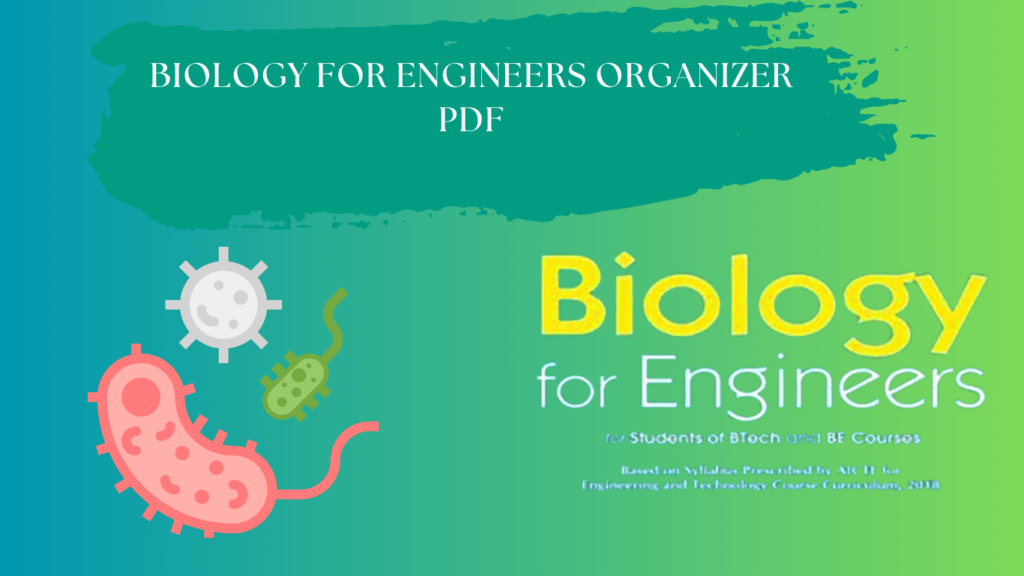Hey Guys Welcome to CSE Study247,This page you can Download the Biology for Engineers Organizer PDF that is useful for many university Exams (BEU Bihar).

Table of Contents
About Biology
- Biology is the study of life.
- Biology is a branch of science that deals with living organisms and their virtual process (virtual process means how to work).
Below Syllabus given, if your syllabus same then definitely you can download this PDF and learn and if need to buy this PDF the Amazon Link is given.
About Publication
| Name | Details |
|---|---|
| Publisher | CBS PUBLISHERS AND DISTRIBUTORS PVT. LTD |
| Language | English |
| Total Page in PDF | 209 |
| Size of the PDF | 40.8 MB |
| Course | BE/B.Tech |
Syllabus Biology for Engineers
Module 1: Introduction
Purpose: To convey that Biology is as important a scientific discipline as Mathematics, Physics and Chemistry.
- Bring out the fundamental differences between science and engineering by drawing a comparison between eye and camera, Bird flying and aircraft.
- Mention the most exciting aspect of biology as an independent scientific discipline.
- Why do we need to study biology?
- Discuss how biological observations of 18th Century lead to major discoveries. Examples from Brownian motion and the origin of thermodynamics refer to the original observation of Robert Brown and Julius Mayor. These examples will highlight the fundamental importance of observations in any scientific inquiry.
Module 2: Classification
Purpose: To convey that classification per se is not what biology is all about. The underlying criterion, such as morphological, biochemical or ecological be highlighted.
Hierarchy of life forms at the phenomenological level. A common thread weaves this hierarchy Classification. Discuss classification based on
- (a) cellularity- Unicellular or multicellular
- (b) ultrastructure- prokaryotes or eucaryotes.
- (c) energy and Carbon utilisation -Autotrophs, heterotrophs, lithotropes
- (d) Ammonia excretion – aminotelic, uricoteliec, ureotelic
- (e) Habitataacquatic or terrestrial
- (f) Molecular taxonomy- three major kingdoms of life.
- A given organism can come under different category based on classification. Model organisms for the study of biology come from different groups. E.coli, S.cerevisiae, D. Melanogaster, C. elegance, A.Thaliana, M. musculus.
Module 3: Genetics
Purpose: To convey that “Genetics is to biology what Newton’s laws are to Physical Sciences”
- Mendel’s laws, Concept of segregation and independent assortment.
- Concept of allele. Gene mapping, Gene interaction, Epistasis. Meiosis and Mitosis be taught as a part of genetics.
- Emphasis to be give not to the mechanics of cell division nor the phases but how genetic material passes from parent to offspring.
- Concepts of recessiveness and dominance.
- Concept of mapping of phenotype to genes. Discuss about the single gene disorders in humans. Discuss the concept of complementation using human genetics.
Module 4: Biomolecules
Purpose: To convey that all forms of life has the same building blocks and yet the manifestations
are as diverse as one can imagine
- Molecules of life. In this context discuss monomeric units and polymeric structures.
- Discuss about sugars, starch and cellulose. Amino acids and proteins.
- Nucleotides and DNA/RNA.
- Two carbon units and lipids.
Module 5: Enzymes
Purpose: To convey that without catalysis life would not have existed on Earth Enzymology:
- How to monitor enzyme-catalysed reactions.
- How does an enzyme catalyse reactions?
- Enzyme classification.
- Mechanism of enzyme action.
- Discuss at least two examples. Enzyme kinetics and kinetic parameters.
- Why should we know these parameters to understand biology? RNA catalysis.
Module 6: Information Transfer
Purpose: The molecular basis of coding and decoding genetic information is universal Molecular
basis of information transfer
- DNA as a genetic material. Hierarchy of DNA structure- from single
stranded to double helix to nucleosomes. - Concept of genetic code.
- Universality and degeneracy of genetic code.
- Define gene in terms of complementation and recombination.
Module 7: Macromolecular analysis
Purpose: How to analyse biological processes at the reductionist level Proteins- structure and
function.
- Hierarch in protein structure. Primary secondary, tertiary and quaternary structure.
- Proteins as enzymes, transporters, receptors and structural elements.
Module 8: Metabolism
Purpose: The fundamental principles of energy transactions are the same in physical and
biological world.
- Thermodynamics as applied to biological systems. Exothermic and endothermic versus
endergonic and exergoinc reactions. - Concept of Keqand its relation to standard free energy.
Spontaneity. ATP as an energy currency. This should include the breakdown of glucose to CO2 - H2O (Glycolysis and Krebs cycle) and synthesis of glucose from CO2 and H2O
(Photosynthesis). Energy yielding and energy consuming reactions. - Concept of Energy charge.
Module 9: Microbiology
Purpose: Concept of single-celled organisms.
- Concept of species and strains.
- Identification and classification of microorganisms.
- Microscopy. Ecological aspects of single celled organisms.
- Sterilization and media compositions.
- Growth kinetics.
Download Biology for Engineers Organizer PDF
Some Important Link
| Official Telegram | Click Here |
| Join BEU Info | Click Here |
| CSE Placement Study materials | Click Here |
| DRDO & ISRO Job Updates | Click Here |
Related Link to BEU Bihar
- BEU 3rd Sem Organizer PDF of Computer Science
- CSE 3rd Sem Notes PDF of BEU Bihar
- Computer Science MCQs
- Computer Organization and Architecture Notes PDF BEU Bihar
- CSE 4th Sem Question Paper of BEU Bihar
- Download Syllabus of Computer Science BEU Bihar
- Download Analog Electronics organizer PDF BEU Bihar
- Download Technical Writing Notes PDF BEU Bihar
Disclaimer
csestudy247 does not own this book/materials, neither created nor scanned. we provide the links that are already available on the internet. For any quarries, Disclaimer is requested to contact us kindly, We assure you we will do our best. We DO NOT SUPPORT PIRACY, this copy was provided for students who are financially troubled but deserve to learn. For queries and suggestions, feel free to contact us ([email protected]) Thank you